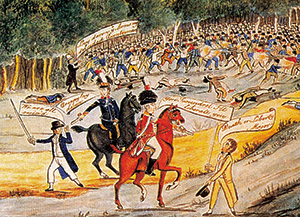March 04
Published in On this Day listing- 1972 Two women were killed and c. 70 injured, many losing limbs, when an IRA bomb exploded without warning in the crowded Abercorn Bar in Belfast’s city centre.

Above: Painting by an unknown artist of the ‘second Battle of Vinegar Hill’, Castlebrook, near Sydney, 1804. (National Library of Australia)
- 1804 The Castle Hill (New South Wales) convict rebellion. Under cover of darkness, over 200 convicts (mainly Irish) escaped from Castle Hill government farm, some 30km west of Sydney town, intending to march there and ‘capture ships to sail to Ireland’. Their leader was Kerry-born United Irishman Philip Cunningham, a stonemason by trade, who had arrived in the colony four years earlier on the Anne, packed with transported fellow United Irishmen. In the course of that voyage he had taken part in a failed mutiny. As with rebel aspirations at home, things did not go according to plan. Though the escapees were reasonably well armed after raids on neighbouring homes, reinforcements from other convict stations failed to show up, forcing Cunningham to make camp and contemplate his next move. Meanwhile, he was elected ‘King of the Australian Empire’ by his followers, who designated the surrounding area as ‘New Ireland’. ‘New Ireland’, however, was short-lived. Having tracked them down, Major George Johnston, at the head of a contingent of redcoats, called on them to surrender and twice sent a priest to negotiate. But Cunningham stood firm, demanding ‘death or liberty, and a ship to take us home’. The subsequent battle, dubbed ‘the second Battle of Vinegar Hill’, was considerably less brutal than the first. Just one volley from Johnston’s men, which killed some fifteen rebels and wounded dozens of others, put the remainder to flight, and over the next few days c. 230 of them were arrested. While most were flogged, Cunningham and eight others were hanged and their bodies placed on gibbets. In 1982 a memorial marking the rebellion was placed in a nearby cemetery within Castlebrook Memorial Park.
- 1972 Two people were killed and a further 136 were injured when the Provisional IRA bombed the Abercorn Restaurant in Belfast.
- 1966 Capital punishment was abolished in Northern Ireland, except for political murders.
- 1918 Army cook Albert Gitchell and over 100 other soldiers at Camp Funston, Kansas, fell ill with what became known as ‘Spanish ’Flu’, a worldwide pandemic that infected c. 500 million by the end of 1920, at least 50 million of them fatally.
- 1867 The Fenian Rising took place, with outbreaks in several counties, notably Tallaght, Co. Dublin, and ended in failure.
- 1864 Daniel Mannix, archbishop of Melbourne (1917–63) and staunch Irish nationalist, born in Charleville, Co. Cork.
- 1778 Robert Emmet, United Irishman, born at St Stephen’s Green West, Dublin, the youngest son of Dr Robert Emmet, state physician.
- 1824 The Royal National Lifeboat Institution (RNLI) was founded by Sir William Hillary. To date the organisation has saved over 144,000 lives at sea.
- 1974 Harold Wilson became British prime minister at the head of a minority Labour government.
'
















